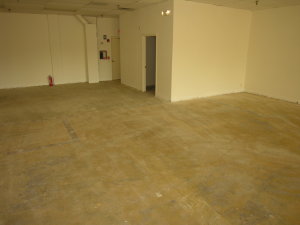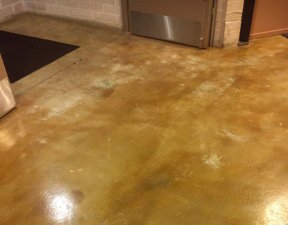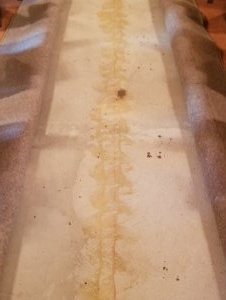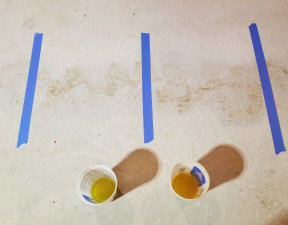The concrete floor in this retail store space is completely covered with a 1/8”-thick layer of yellow carpet glue. Carpet glue on residential concrete is applied much more sparingly, often just in rows or in isolated areas.
If you’re planning to acid-stain a concrete floor in your home or business, carpet glue can be one of the most difficult construction-related residues you will encounter in getting the concrete clean enough to stain. As a decorative flooring contractor in business for almost twenty years, we have worked on a lot of concrete floors covered, partially or wholly, with carpet glue. Sometimes, the glue is visible - it’s usually a shade of yellow - other times, it can be obscured by a layer of tile adhesive, or discolored from dirt, dust and other debris. We have used many different products and techniques on carpet glue, and this article will outline some of the best and most effective.
This is a great “What’s New” topic for our blog, because there currently isn’t much good information on the Internet about removing carpet glue from concrete, beyond tales from do-it-yourselfers, using hot water and scraping. The reason for this is first, there aren’t many contractors who specialize in acid-staining. The majority of contractors involved in acid-staining are either painters, who take on projects when the opportunity arises with one of their painting customers, or concrete contractors, who have an employee or small division that markets themselves for this work to a homeowner after they have poured a new concrete floor or slab.
This condominium concrete floor was acid-stained by a commercial cleaning contractor. In their haste to get the project done, they didn’t remove all the carpet glue, and the remaining residue left bare spots across the floor.
Second, because these contractors only acid-stain on a part-time basis, they usually take the easy way out, and do just enough to get by. For painters, this generally means stripping, sanding and scraping as much glue from the floor that they can get up a single day, and then applying the stain over the remainder, hoping it won’t show up in the end. The problem is, leftover glue and other hard to see contaminants always do show up, because this residue prevents acid stain from reaching, and reacting with, the concrete, thus leaving bare spots across the surface of the newly colored floor. Just as bad, the methylene chloride strippers painters commonly use, darken concrete in the stripping process, and leave permanent application marks.
Concrete contractors, on the other hand, usually do a good job of removing carpet glue and other contaminants from concrete, because needing to get the project done as quickly as possible so as to move on to the next job, they will generally use the fastest and most effective means: large, walk-behind grinding equipment for the main part of the floor, and hand-held grinders along the walls, and in the corners. The problem with this is that, along with the carpet glue, the grinding removes valuable cement from the surface that is important for acid staining. Grinding also leaves swirls, scratches and gouges in the concrete, and exposes fine and medium-sized aggregate that you normally wouldn’t see.
Here, water-based acrylic concrete stain is being applied, instead of acid stain, over a poorly prepared concrete floor in the hopes of covering up imperfections. Water-based stains are a bad choice, because they leave pattern application marks and don’t look natural.
In addition to these problems, project owners invariably then have difficulty convincing the painting or concrete contractor to stick to the original plan, and actually acid-stain the concrete, instead of proposing something else, like water-based stain or an epoxy coating. In our experience over the past 19 years, we have learned through discussions with our customers that most other contractors, even those specializing in decorative concrete, will simply tell project owners, who have concrete floors covered with carpet glue, that their floor can’t be acid-stained, and that there is a better option , like “metallic epoxy”. This is because metallic epoxy is a coating that just covers everything up, and can be installed in a single day. There is no artistic skill involved.
Contrary to what most contractors believe, it is possible to successfully remove carpet glue from concrete, without altering or ruining the cement in the process, and end up with a fantastic looking acid- stained concrete floor. Even if you can’t find an acid-staining or decorative concrete flooring contractor to do the work for you, carpet glue removal is a project that anyone with a little determination and persistence can tackle on their own. Removing carpet glue from concrete still may involve many of the methods mentioned above - stripping, sanding, scraping and grinding - the difference is, it requires a more nuanced approach, and a little more thought, attention, and diligence than most contractors are willing to put in.
Even though there wasn’t a whole lot of carpet glue on the concrete floor in this church, it took a great deal of time for us to remove because the glue had become very dense and hard over a long period of time.
We recently completed an acid-stained concrete flooring project in the main sanctuary of a church, before the Christmas holidays, that presented a huge challenge in terms of removing carpet glue. The glue was thickly applied, and very old (35 years) so it had crystallized into a very dense material. Initially, we couldn’t find a chemical stripper or any adhesive remover that would even dent the surface. We knew we would be able to get the glue off with methylene chloride, or grind it off, but we didn’t want to ruin the cement surface of the concrete in the process. So we did further research and patiently tried every possible product we became aware of until we found something that worked.
The first thing to remember when dealing with carpet glue is that it isn’t like paint, coatings, or adhesives under most floor coverings, such as tile, linoleum, hardwood or wood laminate, that may cover the entire surface of a concrete floor. Carpet glue is light and translucent in color, making it difficult to see, and and it usually covers only portions of a floor, for example, under seams where individual sections or rolls of carpet and padding meet. In addition, carpet glue is not forcefully pressed into the concrete, but just lightly applied to the surface, enough to keep the carpet in place. As a result, in most instances, carpet glue does not leave any permanent or indelible marks on the concrete, and can be effectively removed.
The next thing to keep in mind is that there are three types of “carpet glue”, and that they are not all the same. First, there is water-based carpet glue. It usually comes in plastic containers, and is prevalent these days because it has low volatile organic compounds (VOC’s), something important to eco-friendly building practices, like the Leadership in Energy and Environmental Design (LEED) program. Second, there is solvent-based carpet glue. It comes in metal containers, and is still used because it is “stickier”, and better resists damp conditions, like in basements or outdoors. Third, you have contact cement, which though technically not a “carpet glue” is still encountered, because it is more durable than traditional carpet glues, looks similar, and works great under the wooden “tack strips” used with carpeting along walls.
Sentinel 626 is a water-based carpet and sheet vinyl adhesive remover. Sentinel Products has been around for over 55 years and has some of the best carpet glue stripping products available.
Common chemical strippers and other adhesive removers found at Home Depot, Lowe’s, and Mennard’s generally are not a good choice for removing these different types of carpet glue. Instead, carpet and tile manufacturers usually make specific products, with certain solvents and active ingredients, that are effective in removing their brands and types of adhesives. Some specialty chemical cleaner manufacturers, like Sentinel, also offer a variety of effective carpet glue removers. For water-based glue, you generally need a water-based glue remover; for solvent-based glue, a solvent-based remover. Also, most carpet glue removers will not work work on contact cement. Contact cement contains dense and hard resins, and rubber, making it very difficult to strip. It requires its own special remover.
As a result, the best approach is usually to try to match the right type of remover with the right type of carpet glue, and if possible, to stay within brands. If you aren’t sure of the type or brand of glue you’re dealing with, the technical and sales representatives of the larger and more popular carpet, tile and adhesive manufacturing companies, can be helpful. When you call the company’s customer service phone number, they will usually transfer you to their lab or tech services department, or put you in touch with a regional sales representative for your geographic area. These representatives often have a science background and have been working in their industry for a long time, so they are able to provide good insight and advice.
Above, we are doing some test samples on glue residue that was particularly difficult to remove. We are using the same type of glue strippers, but different brands - that’s the reason for the slight difference in color.
Once you have done some basic research, the best way to start stripping carpet glue prior to acid-staining, is always to do test samples to determine: A) what type of glue it is; B) what type or brand of chemical stripper will be most effective; and C) whether the stripper may permanently stain the concrete. Carpet glue stripping products are not expensive, and they are usually available in small, quart-size quantities, for about $10, so doing test samples before buying larger quantities is not cost prohibitive. Once you have found an effective stripper, then you can buy it in larger quantities. Carpet glue strippers are not expensive, but they don’t have a high coverage rate, so you may end up buying a lot of material.
You should also do the test samples on an inconspicuous area of the floor, like a closet, stairwell, or an area of the floor receiving another type of floor covering, since certain strippers containing methylene chloride, and naptha, leave residual amounts in the pores of the concrete that are difficult to remove and will block the absorption of acid stain. Acid stain may still be effective after these type of strippers have been used, and partially color the concrete, but the shadowing left behind will usually make the coloring there darker than the rest of the floor. So once you do a test sample with a glue remover, you should also test that area with stain, along with another section of concrete where stripper was not applied.
On the above acid-stained concrete floor, you can see three parallel “bands” of coloring that are a slight shade darker brown than the rest of the floor. This is due to shadowing left behind from carpet glue stripper.
The amount of time the carpet glue has been on the floor since it was first applied is also important. Generally, the longer the glue has been there, the more difficult it will be to strip. You may not be able to determine the exact amount of time, but just knowing whether it’s been several years, as opposed to a couple decades, can make a big difference. Carpet glues, and other adhesives, continue to dry and densify over long periods of time, making them harder for chemical strippers to soften and emulsify. As a result, the stripper may need to sit for a longer period of time, or you may need to cover it with plastic so that it doesn’t dry out before having sufficient time to work. Additional applications of the stripper may also be required.
Once most of the glue has been stripped, the floor needs to be scrubbed several times with a rotary floor machine, using a black nylon stripping pad, hot water and detergent. This helps lift the remaining residue that can not be scraped up. Rotary floor machines can be rented inexpensively at most Home Depot stores and tool rental companies.
Overall, stripping carpet glue from concrete can be tedious, time-consuming, and cumbersome. It is possible, however, and if done in the right manner will make a huge difference in the acid-staining result. Additionally, stripping carpet glue is always much better than grinding - not only because the grinding process removes cement from the surface, but because on rough textured or lightly troweled concrete, grinding often won’t even reach residue in the pores of the concrete until a great deal of cement has been ground from the surface. Because most concrete floors are not completely level, even more cement may have to be ground off to reach pores in low spots of the floor.
There was so much material on the surface of this concrete, including paint, glue, and previously applied cement overlays, that it had to be ground off, leaving exposed aggregate (upper right corner of photo).
There are some cases where chemical strippers alone - even repeated applications - will not get a concrete floor clean enough to stain. Some grinding may still have to be done. But it’s always better to get as much carpet glue off of the concrete, first, before doing any grinding, because grinding always negatively affects the staining result. Areas of concrete that have been ground expose aggregate, and the coloring from acid stain in those areas will be considerably darker and more uniform. Different types and grits of grinding discs, wheels, and abrasive pads can be used to minimize these effects, but only an experienced contractor would be able to determine which media would work best in a given situation.
Finally, there are some concrete floors, especially in older homes, and retail store plazas, where so many different floor coverings and adhesives have been used on the concrete, in terms of total surface area, and overall thickness, that chemical stripping may not even be viable. Grinding alone may have to be done, and as a result, the surface of the concrete will be altered. In such instances, all hope is not lost. If the grinding is done in a professional manner, acid-staining the concrete afterward may still be possible, and may turn out great. Sometimes, grinding can also be confined to certain areas of a floor, and then artistic means of applying the stain, like, multiple colors, can camouflage the variations in the outcome.
Lastly, as an alternative, thin, polymer-modified cement overlays may be applied, after grinding, to resurface the concrete, if it is still in really bad shape. Cement overlays are generally too involved and difficult for homeowners or do-it-yourselfers to install, but experienced and reputable contractors can install them quickly and relatively inexpensively. Once the cement overlay is installed, then you can proceed with the acid staining. Cement overlays fill in surface defects, cover up exposed aggregate, and provide a brand new surface containing white cement, which is ideal for acid staining, since color results end up being more vibrant than with traditional gray Portland cement.
This barber shop floor was covered with 1/4” of thick, gooey carpet glue (above left). We had to strip the tacky top layer, and then grind off the lower, denser layer. The cleaned concrete was so uneven, pitted, and irreversibly stained that we still had to resurface it with a white cement overlay (above right) before acid-staining.









